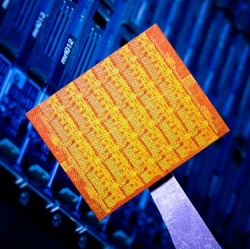
During the past months we’ve been reporting several breakthroughs in the field of quantum computing, and now IBM seems ready to truly pave the way for quantum computers. Researchers announced they are now able to develop a superconducting qubit made from microfabricated silicon that maintains coherence long enough for practical computation. Whoa! That probably sounds like a lot to swallow, so let’s break it down.
Bits and QubitsInformation is measured in ‘bits’, and a bit may have two positions (described typically as 0 or 1). Quantum computers however don’t use these bits, and instead they use quantum bits, or ‘qubits’. But while a bit must be a 0 or a 1, a qubit can be both 0, 1, or a superposition of both. This difference might seem small and subtle, but in fact, it is absolutely humongous: a mere hundred qubits can store more classical ‘bit’ information than there are atoms in the Universe.
Three superconducting qubits. Credits: IBM research
Needless to say a computer running on qubits would be game changing, in pretty much the same way microprocessors were in their days. But what makes quantum computing extremely difficult is a problem called ‘decoherence‘. In the quantum world, things don’t happen as they do in the ‘real world’; when a qubit will move from the 0 state to the 1 state or to a superposition, it will decohere to state 0 due to interference from other parts of the computer. Generally speaking, decoherence is the loss order of the phase angles between the components. So in order for quantum computers to be practical and scalable, the system would have to remain coherent for a long enough time to allow error-correction techniques to function properly.
“In 1999, coherence times were about 1 nanosecond,” said IBM scientist Matthias Steffen. “Last year, coherence times were achieved for as long as 1 to 4 microseconds. With these new techniques, we’ve achieved coherence times of 10 to 100 microseconds. We need to improve that by a factor of 10 to 100 before we’re at the threshold we want to be. But considering that in the past ten years we’ve increased coherence times by a factor of 10,000, I’m not scared.”
